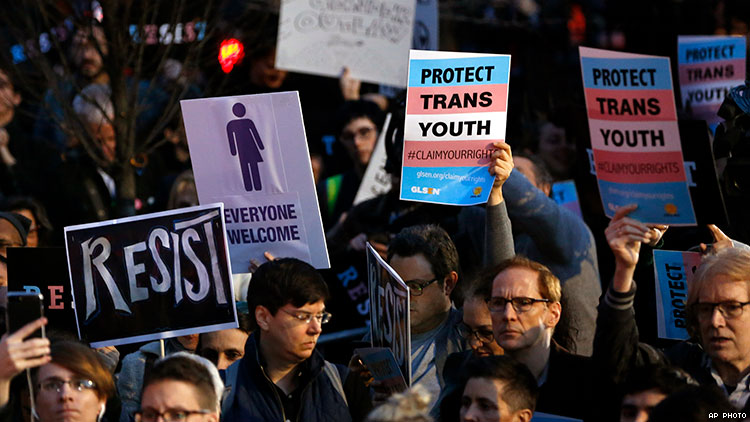A team of Boston researchers published an article in JAMA Psychiatry investigating the impact of non-gender affirmative treatment on transgender people. Of the nearly 28,000 adult transgender survey respondents, close to 20,000 had spoken to a professional about their gender identify, of whom almost 4,000 reported exposure to gender identity conversion efforts (GICE). Lifetime exposure to GICE was significantly associated with severe psychological distress in the last month as well as lifetime suicide attempts, and exposure before the age of ten was significantly associated with lifetime suicide attempts.
“GICE is associated with adverse mental health outcomes in adulthood, including severe psychological distress, lifetime suicidal ideation, and lifetime suicide attempts,” write the authors.
“In this study, exposure to GICE before age 10 years was associated with adverse mental health outcomes compared with therapy without conversion efforts. Results from this study support past positions taken by leading professional organizations that GICE should be avoided with children and adults.”
 Literature has established that transgender people have a higher prevalence of adverse mental health outcomes and that gender-affirming care is associated with positive mental health outcomes as contrasted to gender conversion ‘therapy.’ Numerous professional organizations such as the American Medical Association and the American Psychiatric Association have labeled the ‘therapy’ unethical and ineffective, yet non-licensed religious advisers and mental health practitioners have nonetheless advertised GICE.
Literature has established that transgender people have a higher prevalence of adverse mental health outcomes and that gender-affirming care is associated with positive mental health outcomes as contrasted to gender conversion ‘therapy.’ Numerous professional organizations such as the American Medical Association and the American Psychiatric Association have labeled the ‘therapy’ unethical and ineffective, yet non-licensed religious advisers and mental health practitioners have nonetheless advertised GICE.
The prevailing wisdom is that gender identity stabilizes after puberty, and as such most GICE efforts have focused on young children. There has been an increased understanding that gender diversity is not a ‘disease that requires alteration,’ but the practice remains nonetheless.
To evaluate the prevalence and impact of GICE, the researchers evaluated results from the 2015 US Transgender Survey, which received 27,715 responses from trans adults in the US. They analyzed whether individuals had ever experienced GICE, age of exposure, source of exposure, psychological distress, binge drinking, cigarette and drug usage, suicidal ideation, and suicide attempts. Demographic and socioeconomic variables served as controls.
After adjusting for demographic variables, lifetime exposure to GICE significantly associated with multiple outcomes such as severe psychological distress during the previous month, lifetime suicide attempts; exposure to GICE before the age of ten significantly associated with multiple measures of suicidality such as lifetime suicide attempts.
There was no statistically significant difference between those exposed to GICE by secular vs. religious professionals. Once sexual orientation conversion efforts were taken into account, both lifetime exposure and childhood exposure to GICE associated only with lifetime suicide attempts. The study was limited by the cross-sectional design, lack of data on duration, frequency and forcefulness of GICE, inability to capture GICE in non-professional settings, and not knowing at which age respondents received non-GICE therapy.
“Based on the findings of the current study, it appears that transgender people are exposed to GICE at high rates, perhaps even higher than the percentage of cisgender non- heterosexual individuals who are exposed to sexual orientation conversion efforts, although direct comparisons are not possible,” write the authors.
“One potential explanation for this is that compared with persons in the sexual minority group, many persons in the gender minority group must interact with clinical professionals to be medically and surgically affirmed in their identities. This higher prevalence of interactions with clinical professionals among people in the gender minority group may lead to a greater risk of experiencing conversion efforts.”
While other studies have found that conversion efforts for sexual orientation significantly associated with depression and suicidal ideation, this study was the first to find an association between any conversion efforts and suicidal ideation as well as attempts. The authors suggest that GICE may associate with emotion dysregulation, interpersonal dysfunction, and maladaptive cognitions.
Those in lower socioeconomic groups had a higher likelihood of being exposed to GICE; due to the cross-sectional design, the authors could not suggest whether lower-SES individuals were more likely to receive GICE, or whether GICE was so emotionally damaging that future educational, professional, and economic challenges emerged.
There has been a concern that early exposure to GICE may lead to feelings of shame, and this current study expanded that to focus on adverse mental health outcomes. Early rejection of gender identity may have important developmental implications. As such, the authors recommend against such ‘therapy’ at any age, suggesting that any intervention to alter gender identity is associated with poorer mental health.
****
Turban, J.L., Beckwith, N., Reisner, S. L., & Keuroghlian, A. S. (2019). Association Between Recalled Exposure to Gender Identity Conversion Efforts and Psychological Distress and Suicide Attempts Among Transgender Adults, JAMA Psychiatry, [ePub ahead of print]. DOI: 10.1001/jamapsychiatry.2019.2285 (Link)















Gender roles – a 100% cultural construct that varies by culture – are harmful, full stop. Suggesting to children that it’s even possible to have been born with the “wrong” sex parts because they don’t conform to cultural expectations for their assigned sex is abuse.
Not confirming a person’s desired gender expression is also abuse. But just because someone expresses themselves differently from the way our culture has pigeonholed expression of sex, sexuality, and gender roles does NOT make them the LITERAL opposite sex.
It’s mindboggling to me the amount of damage this cultural programming is doing to young people – both men and women. What should have ended in a freer society – one in which people can express themselves however they want – men wearing makeup and dresses, women not doing so, not shaving, not conforming – has instead become an even more highly enforced gendered culture.
A man doesn’t need a vagina for permission to be gentle and loving or to be allowed to wear skirts. I don’t need a penis to be dominant, to wear jeans, not shave and eschew toxic, chemical-laden beauty products.
Gendered expectations are the problem, not what sex parts one has.
– An Unapologetic Radical Feminist
Report comment
Rad fem here, too.
Report comment
Thankyou, Kindredspirit, for expressing many of my exact thoughts, but I thought this website is so far to the Left that it would shut me down and sensor me for saying so. This entire debate from both sides misses the point and it saddens me that the issue has only been further muddied and made worse by the current state of war between the two tribes…
Sam
Report comment
**standing ovation to what kindredspirit said**
Report comment
as another Unapologetic Radical Feminist, maybe I should’ve given a standing OVAtion?
Report comment
Not that radical. I’ve read stuff by the late Walter Alvarez, MD, written over 50 years ago on the same topic. He was hardly a left-wing radical, yet he treated the subject evenly, honestly concerning himself with how the matter affected those most affected by “unusual” sexual and gender preferences and beliefs. But then, he was an early advocate of Hoffer and Osmond’s megavitamin B3 therapy for schizophrenia syndrome.
Report comment
Are you saying you consider Alvarez a feminist?
Report comment
Not in the modern sense, but was was no Bible thumper or closet Nazi. He was very open minded for his day and even got his newspaper column demoted to remote regions of the NY Times for bad-mouthing psychoanalysis as a treatment.
Report comment
He was also interested in unusual states of mind, building a collection of several hundred autobiographical books by mental patients, alcoholics and addicts, LGBT folks, including cross-dressers. He wrote reviews about a number of the individuals who appeared in the several hundred volumes in his collection (some, like Aliester Crowley, rather infamous). In his profession he started as a GI man, not a shrink, but became interested in the subject when he experienced a flow of patients with what we used to call psychosomatic gut problems over his GI years. The title of his book was *Minds that Came Back*
Report comment
Report comment
I am thankful for this article. At the same time…
is there some way this data could (possibly) serve as a springboard, from which to take a serious look at the damage caused to all sorts of people from all sorts of counseling, psychotherapy, group therapy, etc.? CBT, DBT, on and on…
harm.many.people.
Report comment
Removed for moderation.
Report comment
Just stating the truth as I see it. I don’t promote hating anyone with my comment. Facts are facts until ‘somebody’ decides they’re not.
Disappointed that there is no freedom to discuss this issue on this site.
Report comment
“As such, the authors recommend against such ‘therapy’ at any age, suggesting that any intervention to alter gender identity is associated with poorer mental health.”
I have a transgender child, and have no doubt, “any intervention to alter” any concern by our “mental health” workers “is associated with poorer mental health.” I’ll just keep loving him/her, and warn against any type of “mental health” services.
Report comment
Who made this determination?
Report comment
Removed for moderation.
Report comment